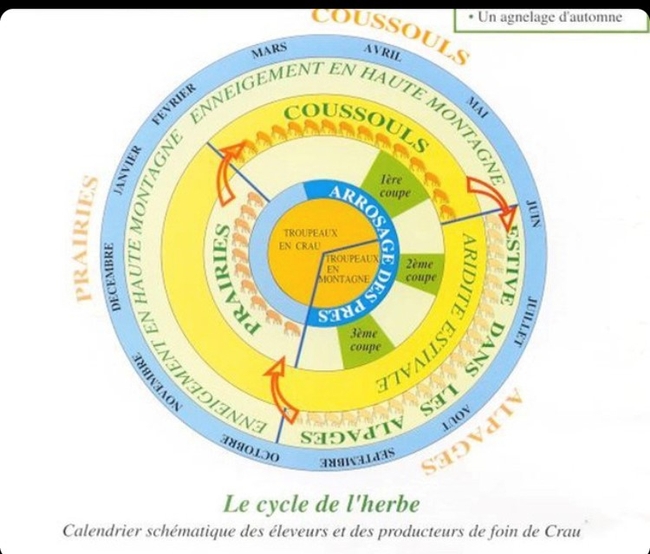Like many of you, I expect, I've recently debated whether to keep my social media accounts - Twitter, Facebook, and Instagram sometimes seem like a bottomless pit of advertising and argument. But then something like this happens....
Last week, I wrote about the idea of an "ecological calendar" - a way to think about our production calendars from an ecological perspective (read the post here). I included my first rather awkward attempt at graphically displaying my own sheep production calendar - and shared the graphic on Instagram.
Within several hours, I had the most wonderful response from someone who listens to our Sheep Stuff Ewe Should Know podcast - complete with an actual, real-world ecological calendar from a famous sheep-producing region in France! Yeva (@why_suarez on Instagram) shared this:
"The inner orange circle says “troupeau en montage” (herd in the mountains) and troupeau en crau (the Crau is a geographical area). Most sheep farmers in the south of France move their sheep to the mountain areas (like Haute Savoie, the mountains between Italy and France. Pyrenees is another system yet again) as there's not enough green pastures available, because of the high temperatures that dry out the land and/or because the irrigated areas are used to produce hay (there are more reasons, but that's the short version!). Wolves are a big issue, they will be guarded by a shepherd throughout the summer. But back to the calendar.
"You see two blue lines pass through all the circles, one: mid-June; one: beginning of October. That's when the sheep are away, which matches with the outer circle that says “estives dans les alpages.” Estives means summer pasture. Most of the sheep will be taken there, represented in the tiny sheep symbols. Outside that period is says in the circle “enneigement en montagne,” which is basically snow in the mountains!
"The arrows show the movement of the sheep to the different kind of pastures. In the Crau, you basically have two kinds, the green one that is irrigated and produces the hay and the dry one or the “Coussouls” that have a very specific kind of biodiversity and is known for its many rocks.
"It's a bit complicated to explain because it's a circular system, so it's all linked – which also makes it very cool, because the entire calendar is pasture and hay based, including lambing dates, etc. But basically, Foins de Crau is a very famous hay that's produced with a complicated irrigation system and is subject to many rules if it wants to qualify as “foins de crau,” as it's known for its very high quality. They cut it three times a year (in the calendar it says “1ere coupe = first cut, etc.). Each “cut” has a different nutritional component and is marketed differently. The fourth cut is not actually cut; it is eaten by the sheep when they return from the mountains. That's why you see the sheep symbols between October and February in the same circle as the “cuts” – we call those kinds of pastures the “prairies.”
"Half February (the blue line only overlaps the prairies and coussouls) they are then moved to the coussouls. The prairies will start growing again for the first foins de crau cut and the cassouls offer enough food. Some other shepherds bring sheep to hill areas nearby instead of the coussouls – it tends to depend on the particularities of that farm. The amount of sheep symbols has grown in the cassouls circle, because the herds tend to be much bigger as this calendar reflects an autumn lambing period, which is the overall tendency here.
"Outside the inner circle is a smaller blue one that shows when the prairies are irrigated with water and when not (“arrossage de pres”). The specific timing of the movement of the herds would be a much longer story! But I hope the different layers of the calendar are clearer now and why they are linked."
I shared this calendar explanation with my friend Dr. Hailey Wilmer, who is the Research Rangeland Management Specialist at the U.S. Range Sheep Production Efficiency Research Unit, in Dubois, Idaho. Her observation was that "calendars can help tell stories across landscapes." I agree - looking at the calendar Yeva shared, and the explanation she provided, helped me look again at my own calendar. I asked myself these questions:
- What is the heart of our sheep operation in terms of nutrition and forage? For us, I think, it's the annual rangeland we use in the winter and again in summer.
- What is the second most important forage resource? In our case, it's our irrigated pasture. Pasture is more productive - and also more costly. With sheep, we could probably figure out how to get along without it.
- Finally, how do our production needs (vaccinations, shearing, lambing, etc.) fit within these underlying forage cycles?
All of this brings me to a question for you! How does your production system fit the ecological cycles in your region? I hope you'll share! And I guess I'll keep my social media accounts for now....
